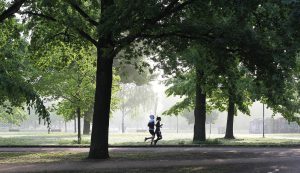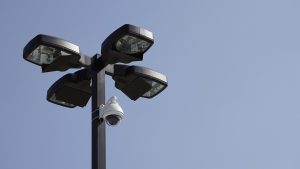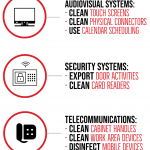Can Technology Enhance Parks?
“Mom, look! It’s a dinosaur!” The boy’s voice rises in excitement as he points to the screen on his mother’s tablet where a stegosaurus lumbers by. He bounces in her lap as she presses a few buttons and points the tablet past the playground to the other side of the park. The scene changes and the trees are now covered in snow as a mammoth raises its trunk, trumpeting loudly.
Not so long ago, a scene like this would have seemed like science fiction, but thanks to today’s technology, this is only one of the ways parents can spend an afternoon at the park with their kids.
Why visit parks?
The list of the benefits provided by parks is very long, positively impacting both physical and mental health. Parks provide opportunities for children to enjoy playground equipment, all ages to participate in sports, and friends and family to spend quality time together. Studies have also shown biophilia, or human beings’ natural affinity for a connection to nature, to have positive health benefits. In fact, nature can have such an impact on mental health that developers and companies are looking for more ways to bring the outdoors indoors, incorporating green roofs, living walls, and programs such as the WELL Building Standard™.
 We often think of nature and technology as opposites; however, technology can actually enhance a person’s park experience. It can even get more people interested in using their local parks, especially young people. Technology makes knowledge more available than ever and parks are the perfect place to take advantage of educational opportunities.
We often think of nature and technology as opposites; however, technology can actually enhance a person’s park experience. It can even get more people interested in using their local parks, especially young people. Technology makes knowledge more available than ever and parks are the perfect place to take advantage of educational opportunities.
Whether through interactive displays and digital signs featuring information about the water cycle, QR codes that identify native plants, or virtual and augmented reality apps that allow visitors to see the prehistoric animals that once populated the area, technology can make learning about nature easy and fun. Visitors can then share the history lessons and conservation tips they learned from the park with their friends and neighbors.
How can wifi be brought to parks?
In order to bring this internet-based knowledge to more people in a convenient way, parks would need to provide public wifi. Wireless access points throughout the park not only allow people to use web-based apps (such as those providing information about activities and species within the park), but create a work and study environment, as well. With proper seating and secure, reliable internet, students and employees of all ages can embrace a change of scenery. In some cases, exposure to nature can even increase productivity, creativity, and concentration.
 Certain buildings within a park may need structured cabling to enable wifi for visitors. This system can be created specifically for the park or, like at Scissortail Park in Oklahoma City, extend from existing systems in buildings surrounding the park. A properly planned structured cabling system enables reliable wifi while addressing the challenges presented by serving a largely outdoor space.
Certain buildings within a park may need structured cabling to enable wifi for visitors. This system can be created specifically for the park or, like at Scissortail Park in Oklahoma City, extend from existing systems in buildings surrounding the park. A properly planned structured cabling system enables reliable wifi while addressing the challenges presented by serving a largely outdoor space.
What about outdoor events?
Many outdoor spaces, especially in compact urban environments, are designed as gathering places for large groups and events. These can include farmer’s markets, concerts, and speeches or presentations. While the types of events held in park areas may vary greatly, they all have one thing in common – a need for comfortable acoustics.
 Concerts and speeches or presentations are classic examples because people are attending (and most often paying) to hear something they are passionate about or interested in. If they cannot hear properly, the experience is ruined. The acoustics of an outdoor space present unique challenges because of the lack of structure (such as walls) sound can bounce off of, making it difficult to hear for some audience members. However, simply adding large speakers can be equally uncomfortable, and even damaging, to eventgoers.
Concerts and speeches or presentations are classic examples because people are attending (and most often paying) to hear something they are passionate about or interested in. If they cannot hear properly, the experience is ruined. The acoustics of an outdoor space present unique challenges because of the lack of structure (such as walls) sound can bounce off of, making it difficult to hear for some audience members. However, simply adding large speakers can be equally uncomfortable, and even damaging, to eventgoers.
“For outdoor venues, one of the most common ways to control and direct sound is to create an envelope at the stage to help reflect sound to audience members,” Jessica Hiatt, CTS-D, an acoustical engineer at IP Design Group explains. “By implementing the appropriate surface materials in the correct configuration, it can greatly improve the acoustical experience.”
Some concerts and presentations also incorporate audiovisual elements to further engage audiences. “Properly locating, aiming, and tuning of the loudspeaker systems can greatly enhance a performance, but the overall levels have to be considered so that they do not exceed noise ordinance levels as set by local authorities,” Hiatt continues. “Considerations for sustainability of equipment have to be taken into account, too, for the environmental conditions that this equipment is being installed in.”
How can technology increase park safety?
Technology also has an important role in creating a safe park environment. Digital signage, structures, and other park amenities are susceptible to vandalism and visitors also need to feel a sense of security when using the space. Surveillance cameras can be located outside structures and other strategic locations throughout the park to both deter vandals and make park-goers feel more comfortable.
 Some parks also use cameras to keep an eye on more than just people. By stationing cameras in birds’ nests or in trees overlooking popular wildlife hangouts, parks can provide people with education and entertainment even when they are not within the park itself. This can encourage conversation about nature and conservation, as well as bring more repeat visitors to the park.
Some parks also use cameras to keep an eye on more than just people. By stationing cameras in birds’ nests or in trees overlooking popular wildlife hangouts, parks can provide people with education and entertainment even when they are not within the park itself. This can encourage conversation about nature and conservation, as well as bring more repeat visitors to the park.
Where does technology in parks go from here?
“Smart” parks are gaining ground throughout the United States as leaders continue to look for ways to encourage people to take advantage of the benefits of their national, state, and local parks. Some parks are using solar benches that track the number of visitors to the park. This can provide valuable information to help park leaders create budgets and help classes, such as group exercise sessions, identify peak activity times. In other places, visitors can use outdoor exercise equipment that will not only build muscle, but charge their cell phones at the same time.
Other parks are deploying Smart Phone applications to enhance the visitor experience. Visitors can use the app to learn about schedules and events while planning their visit. Other features could include: shopping, eating, show reservations, and coupons for their trip.
Where can I learn more?
Read “What is an Acoustical Consultant?” to find out how acousticians can make a space sound more comfortable.
To learn about how biophilia and other natural elements are incorporated into modern buildings, read “What Does a WELL-Designed Building Look Like?”
Discover a wide variety of technologies being used in today’s parks by reading “SMART Parks: A Toolkit.”










